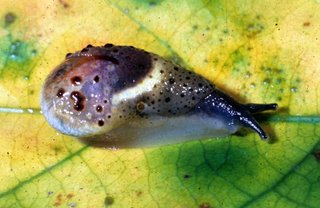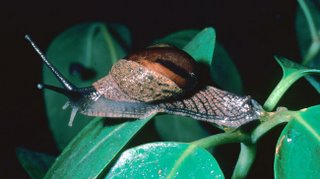South-eastern Australia has cystopeltids, tiny grey-brown slugs that spend their down-time curled up in strips of shed stringybark. (They share this resting spot with fast-moving spiders. Rolled bark contains more surprises than a box of Christmas crackers.) They're not easy to spot. They don't roam about much, although I have found them on on the trunks of tree ferns at Mait's Rest in the Otways.
The rest of the Australian slug population is restricted to eastern Australia. Among them the red-triangle slug (Triboniophorus) and carnivorous Atopos from the tropics.
 But there's a very diverse group that's neither quite a slug nor a snail—the semi-slugs. In Australia, these all belong to the family Helicarionidae. And it's a very diverse family indeed. This is a species from Queensland. As is the case in all helicarionid semi-slugs, the shell is too small and thin to provide protection for the whole animal. It covers the visceral mass (the internal organs) and that's about it. In fact, extensions of body tissue (mantle lappets) cover the shell to protect it. You can see the fingernail of shell between the lobes of skin on the back of the top animal.
But there's a very diverse group that's neither quite a slug nor a snail—the semi-slugs. In Australia, these all belong to the family Helicarionidae. And it's a very diverse family indeed. This is a species from Queensland. As is the case in all helicarionid semi-slugs, the shell is too small and thin to provide protection for the whole animal. It covers the visceral mass (the internal organs) and that's about it. In fact, extensions of body tissue (mantle lappets) cover the shell to protect it. You can see the fingernail of shell between the lobes of skin on the back of the top animal. The second animal shows another characteristic of the group—the upturned tip of the tail. This occurs in all helicarionids but is not found in other Australian snails and slugs. It's even present in the few small species of helicarionid in which the shell is fully-formed.
The second animal shows another characteristic of the group—the upturned tip of the tail. This occurs in all helicarionids but is not found in other Australian snails and slugs. It's even present in the few small species of helicarionid in which the shell is fully-formed.[I have absolutely no recollection of taking these photos. No, I'm not auditioning for a job at the AWB. If I've borrowed them from someone else, could the photographer(s) let me know.]